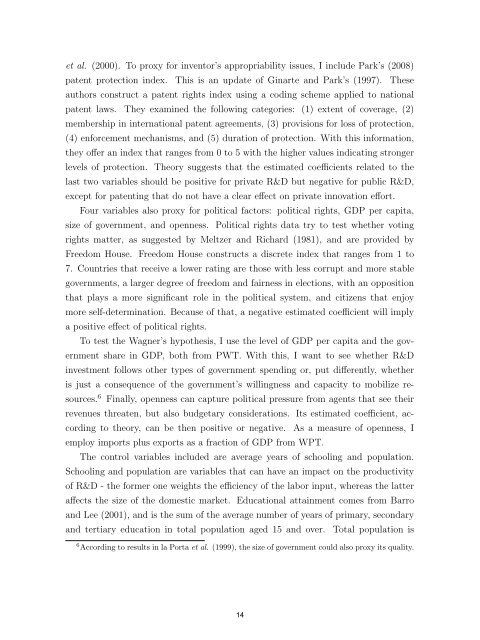Download - Ivie
You also want an ePaper? Increase the reach of your titles
YUMPU automatically turns print PDFs into web optimized ePapers that Google loves.
et al. (2000). To proxy for inventor’s appropriability issues, I include Park’s (2008)<br />
patent protection index. This is an update of Ginarte and Park’s (1997). These<br />
authors construct a patent rights index using a coding scheme applied to national<br />
patent laws. They examined the following categories: (1) extent of coverage, (2)<br />
membership in international patent agreements, (3) provisions for loss of protection,<br />
(4) enforcement mechanisms, and (5) duration of protection. With this information,<br />
they offer an index that ranges from 0 to 5 with the higher values indicating stronger<br />
levels of protection. Theory suggests that the estimated coefficients related to the<br />
last two variables should be positive for private R&D but negative for public R&D,<br />
except for patenting that do not have a clear effect on private innovation effort.<br />
Four variables also proxy for political factors: political rights, GDP per capita,<br />
size of government, and openness. Political rights data try to test whether voting<br />
rights matter, as suggested by Meltzer and Richard (1981), and are provided by<br />
Freedom House. Freedom House constructs a discrete index that ranges from 1 to<br />
7. Countries that receive a lower rating are those with less corrupt and more stable<br />
governments, a larger degree of freedom and fairness in elections, with an opposition<br />
that plays a more significant role in the political system, and citizens that enjoy<br />
more self-determination. Because of that, a negative estimated coefficient will imply<br />
a positive effect of political rights.<br />
To test the Wagner’s hypothesis, I use the level of GDP per capita and the government<br />
share in GDP, both from PWT. With this, I want to see whether R&D<br />
investment follows other types of government spending or, put differently, whether<br />
is just a consequence of the government’s willingness and capacity to mobilize resources.<br />
6 Finally, openness can capture political pressure from agents that see their<br />
revenues threaten, but also budgetary considerations. Its estimated coefficient, according<br />
to theory, can be then positive or negative. As a measure of openness, I<br />
employ imports plus exports as a fraction of GDP from WPT.<br />
The control variables included are average years of schooling and population.<br />
Schooling and population are variables that can have an impact on the productivity<br />
of R&D - the former one weights the efficiency of the labor input, whereas the latter<br />
affects the size of the domestic market. Educational attainment comes from Barro<br />
and Lee (2001), and is the sum of the average number of years of primary, secondary<br />
and tertiary education in total population aged 15 and over. Total population is<br />
6 According to results in la Porta et al. (1999), the size of government could also proxy its quality.<br />
11<br />
14

















